MAN2910 - Business Process Management: Joondalup Hospital Analysis
VerifiedAdded on 2022/07/28
|10
|1700
|22
Case Study
AI Summary
This case study examines the business processes at Joondalup Hospital, identifying key issues such as low efficiency, long patient waiting times, admission procedure bottlenecks, patient flow delays, and unwieldy medical documentation processes. It highlights the potential benefits of implementing robotic process automation (RPA) and artificial intelligence (AI) to streamline operations, improve decision-making, and enhance overall hospital performance. The analysis emphasizes the importance of business process analysis in identifying and resolving inefficiencies to improve patient satisfaction and optimize resource utilization within the hospital environment. The study also includes an 'As-Is' model to visually represent the current state of the hospital's processes and provides references to support the findings and recommendations.
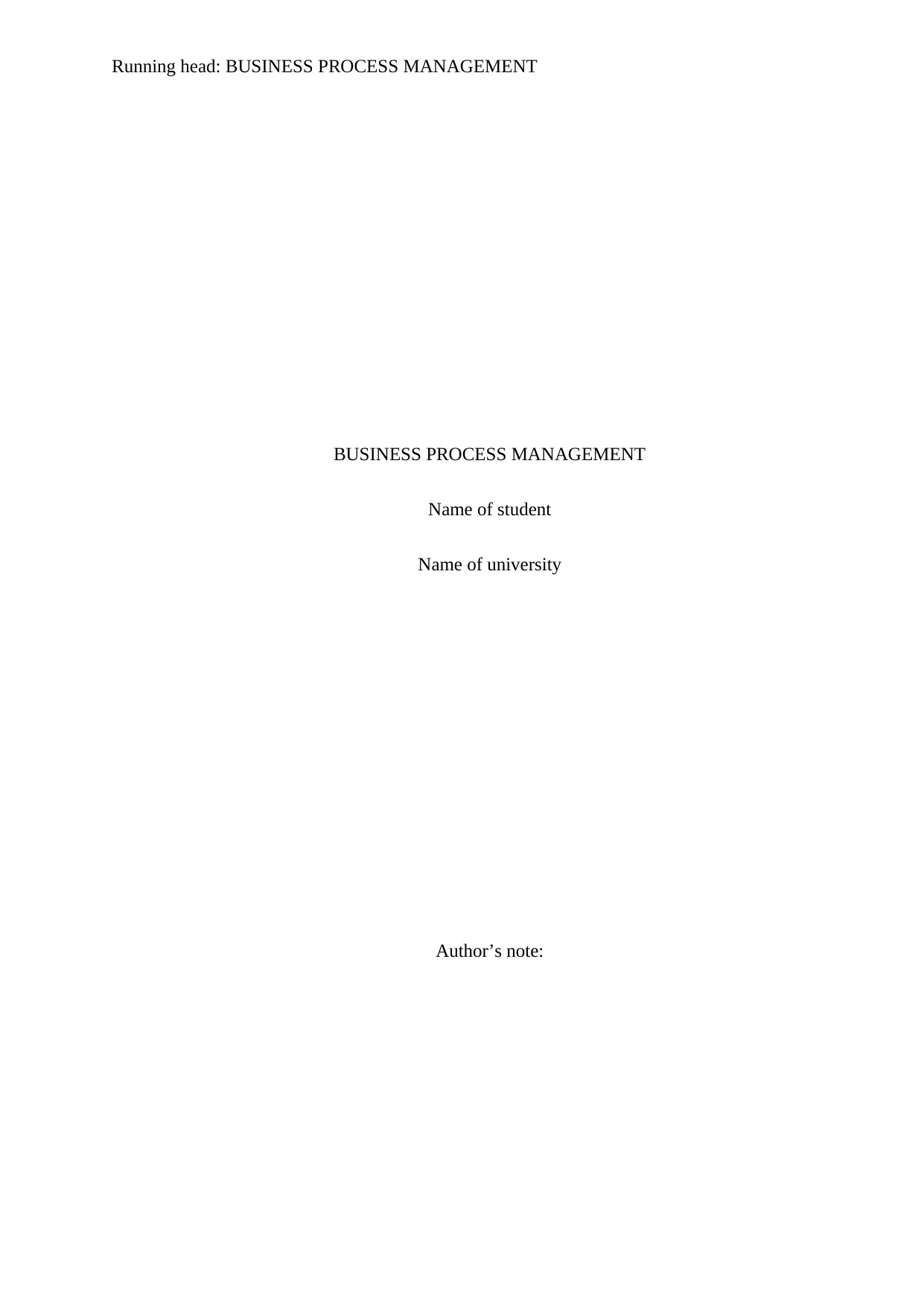
Running head: BUSINESS PROCESS MANAGEMENT
BUSINESS PROCESS MANAGEMENT
Name of student
Name of university
Author’s note:
BUSINESS PROCESS MANAGEMENT
Name of student
Name of university
Author’s note:
Paraphrase This Document
Need a fresh take? Get an instant paraphrase of this document with our AI Paraphraser
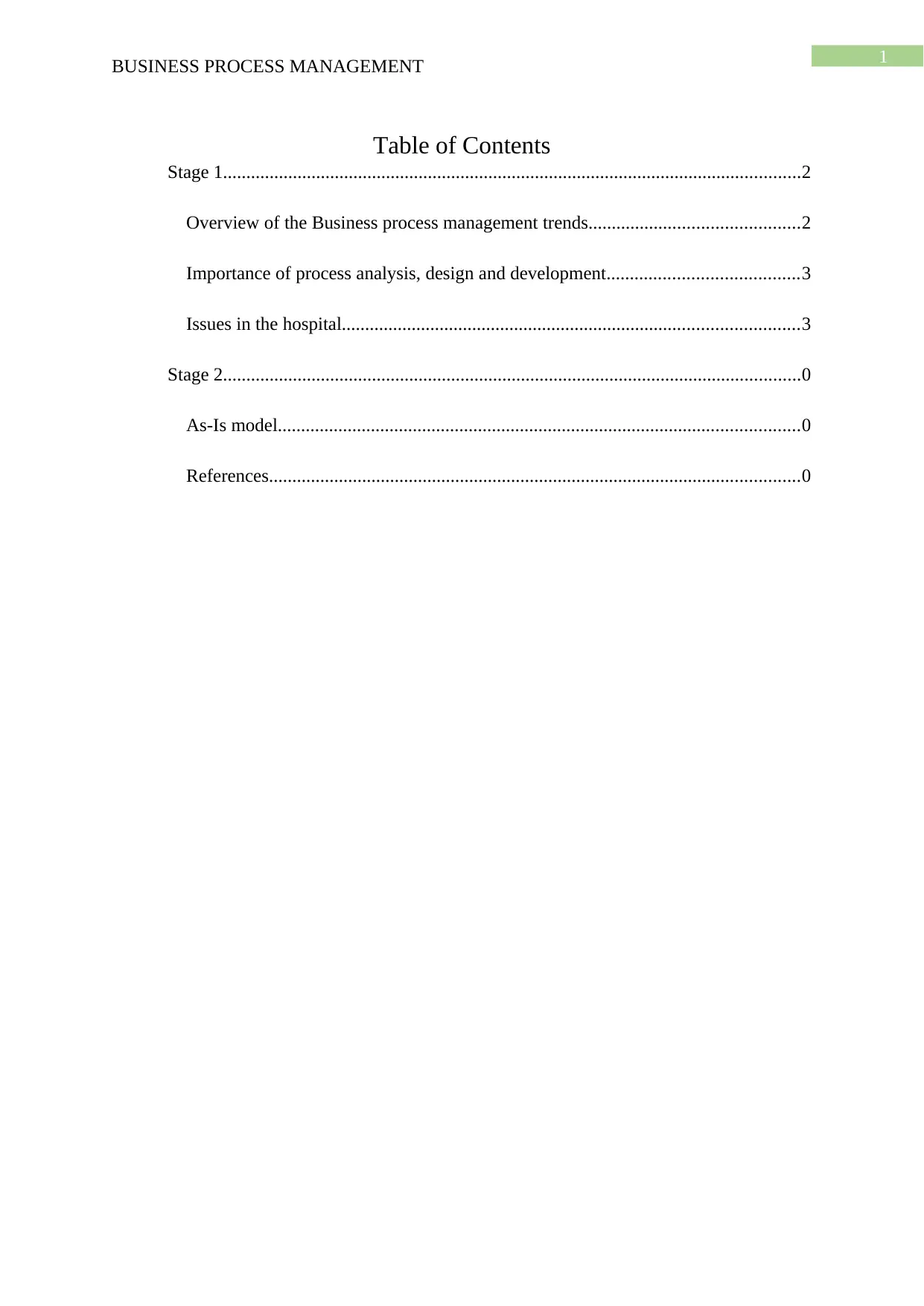
1
BUSINESS PROCESS MANAGEMENT
Table of Contents
Stage 1............................................................................................................................2
Overview of the Business process management trends.............................................2
Importance of process analysis, design and development.........................................3
Issues in the hospital..................................................................................................3
Stage 2............................................................................................................................0
As-Is model................................................................................................................0
References..................................................................................................................0
BUSINESS PROCESS MANAGEMENT
Table of Contents
Stage 1............................................................................................................................2
Overview of the Business process management trends.............................................2
Importance of process analysis, design and development.........................................3
Issues in the hospital..................................................................................................3
Stage 2............................................................................................................................0
As-Is model................................................................................................................0
References..................................................................................................................0
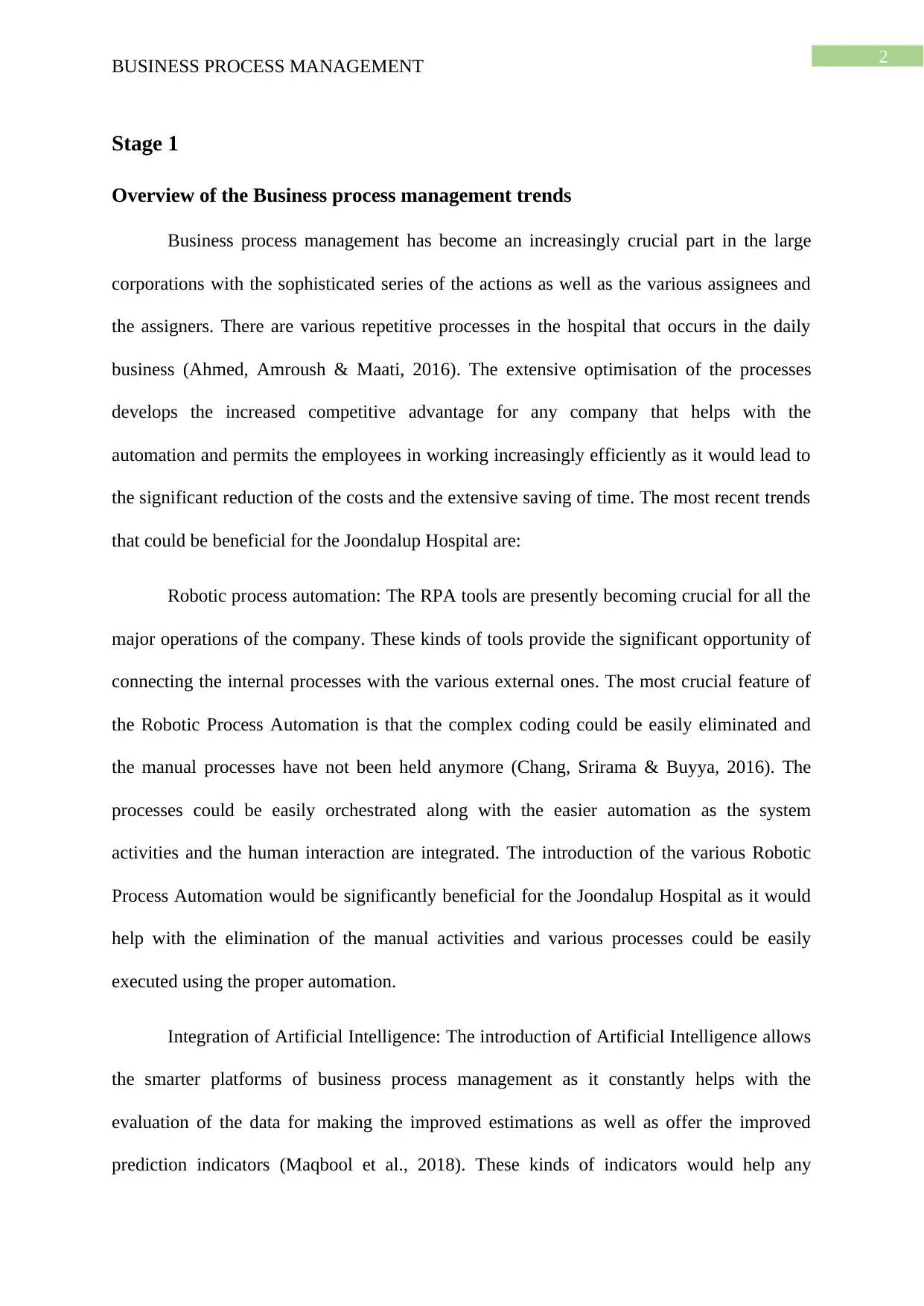
2
BUSINESS PROCESS MANAGEMENT
Stage 1
Overview of the Business process management trends
Business process management has become an increasingly crucial part in the large
corporations with the sophisticated series of the actions as well as the various assignees and
the assigners. There are various repetitive processes in the hospital that occurs in the daily
business (Ahmed, Amroush & Maati, 2016). The extensive optimisation of the processes
develops the increased competitive advantage for any company that helps with the
automation and permits the employees in working increasingly efficiently as it would lead to
the significant reduction of the costs and the extensive saving of time. The most recent trends
that could be beneficial for the Joondalup Hospital are:
Robotic process automation: The RPA tools are presently becoming crucial for all the
major operations of the company. These kinds of tools provide the significant opportunity of
connecting the internal processes with the various external ones. The most crucial feature of
the Robotic Process Automation is that the complex coding could be easily eliminated and
the manual processes have not been held anymore (Chang, Srirama & Buyya, 2016). The
processes could be easily orchestrated along with the easier automation as the system
activities and the human interaction are integrated. The introduction of the various Robotic
Process Automation would be significantly beneficial for the Joondalup Hospital as it would
help with the elimination of the manual activities and various processes could be easily
executed using the proper automation.
Integration of Artificial Intelligence: The introduction of Artificial Intelligence allows
the smarter platforms of business process management as it constantly helps with the
evaluation of the data for making the improved estimations as well as offer the improved
prediction indicators (Maqbool et al., 2018). These kinds of indicators would help any
BUSINESS PROCESS MANAGEMENT
Stage 1
Overview of the Business process management trends
Business process management has become an increasingly crucial part in the large
corporations with the sophisticated series of the actions as well as the various assignees and
the assigners. There are various repetitive processes in the hospital that occurs in the daily
business (Ahmed, Amroush & Maati, 2016). The extensive optimisation of the processes
develops the increased competitive advantage for any company that helps with the
automation and permits the employees in working increasingly efficiently as it would lead to
the significant reduction of the costs and the extensive saving of time. The most recent trends
that could be beneficial for the Joondalup Hospital are:
Robotic process automation: The RPA tools are presently becoming crucial for all the
major operations of the company. These kinds of tools provide the significant opportunity of
connecting the internal processes with the various external ones. The most crucial feature of
the Robotic Process Automation is that the complex coding could be easily eliminated and
the manual processes have not been held anymore (Chang, Srirama & Buyya, 2016). The
processes could be easily orchestrated along with the easier automation as the system
activities and the human interaction are integrated. The introduction of the various Robotic
Process Automation would be significantly beneficial for the Joondalup Hospital as it would
help with the elimination of the manual activities and various processes could be easily
executed using the proper automation.
Integration of Artificial Intelligence: The introduction of Artificial Intelligence allows
the smarter platforms of business process management as it constantly helps with the
evaluation of the data for making the improved estimations as well as offer the improved
prediction indicators (Maqbool et al., 2018). These kinds of indicators would help any
⊘ This is a preview!⊘
Do you want full access?
Subscribe today to unlock all pages.

Trusted by 1+ million students worldwide
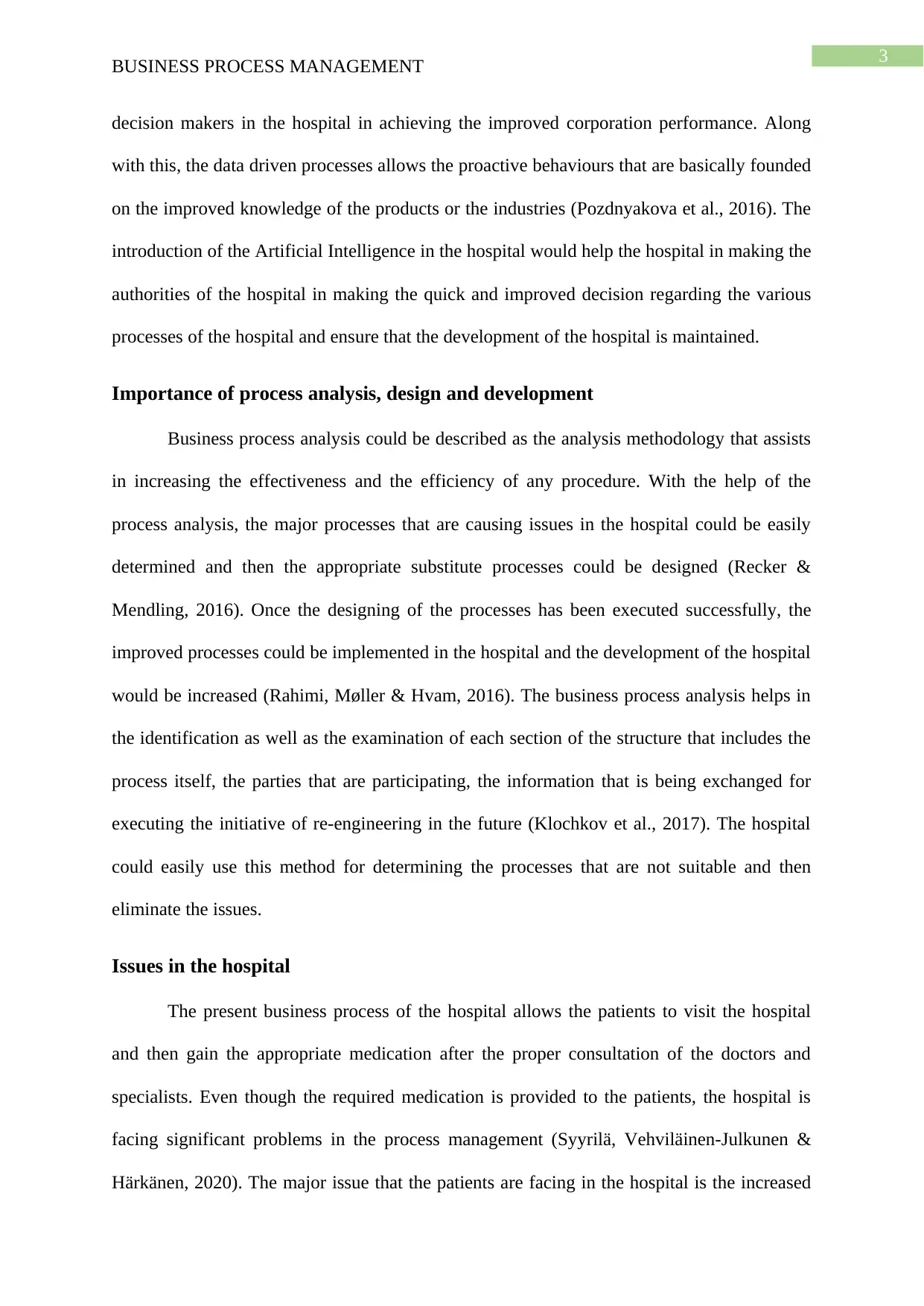
3
BUSINESS PROCESS MANAGEMENT
decision makers in the hospital in achieving the improved corporation performance. Along
with this, the data driven processes allows the proactive behaviours that are basically founded
on the improved knowledge of the products or the industries (Pozdnyakova et al., 2016). The
introduction of the Artificial Intelligence in the hospital would help the hospital in making the
authorities of the hospital in making the quick and improved decision regarding the various
processes of the hospital and ensure that the development of the hospital is maintained.
Importance of process analysis, design and development
Business process analysis could be described as the analysis methodology that assists
in increasing the effectiveness and the efficiency of any procedure. With the help of the
process analysis, the major processes that are causing issues in the hospital could be easily
determined and then the appropriate substitute processes could be designed (Recker &
Mendling, 2016). Once the designing of the processes has been executed successfully, the
improved processes could be implemented in the hospital and the development of the hospital
would be increased (Rahimi, Møller & Hvam, 2016). The business process analysis helps in
the identification as well as the examination of each section of the structure that includes the
process itself, the parties that are participating, the information that is being exchanged for
executing the initiative of re-engineering in the future (Klochkov et al., 2017). The hospital
could easily use this method for determining the processes that are not suitable and then
eliminate the issues.
Issues in the hospital
The present business process of the hospital allows the patients to visit the hospital
and then gain the appropriate medication after the proper consultation of the doctors and
specialists. Even though the required medication is provided to the patients, the hospital is
facing significant problems in the process management (Syyrilä, Vehviläinen‐Julkunen &
Härkänen, 2020). The major issue that the patients are facing in the hospital is the increased
BUSINESS PROCESS MANAGEMENT
decision makers in the hospital in achieving the improved corporation performance. Along
with this, the data driven processes allows the proactive behaviours that are basically founded
on the improved knowledge of the products or the industries (Pozdnyakova et al., 2016). The
introduction of the Artificial Intelligence in the hospital would help the hospital in making the
authorities of the hospital in making the quick and improved decision regarding the various
processes of the hospital and ensure that the development of the hospital is maintained.
Importance of process analysis, design and development
Business process analysis could be described as the analysis methodology that assists
in increasing the effectiveness and the efficiency of any procedure. With the help of the
process analysis, the major processes that are causing issues in the hospital could be easily
determined and then the appropriate substitute processes could be designed (Recker &
Mendling, 2016). Once the designing of the processes has been executed successfully, the
improved processes could be implemented in the hospital and the development of the hospital
would be increased (Rahimi, Møller & Hvam, 2016). The business process analysis helps in
the identification as well as the examination of each section of the structure that includes the
process itself, the parties that are participating, the information that is being exchanged for
executing the initiative of re-engineering in the future (Klochkov et al., 2017). The hospital
could easily use this method for determining the processes that are not suitable and then
eliminate the issues.
Issues in the hospital
The present business process of the hospital allows the patients to visit the hospital
and then gain the appropriate medication after the proper consultation of the doctors and
specialists. Even though the required medication is provided to the patients, the hospital is
facing significant problems in the process management (Syyrilä, Vehviläinen‐Julkunen &
Härkänen, 2020). The major issue that the patients are facing in the hospital is the increased
Paraphrase This Document
Need a fresh take? Get an instant paraphrase of this document with our AI Paraphraser
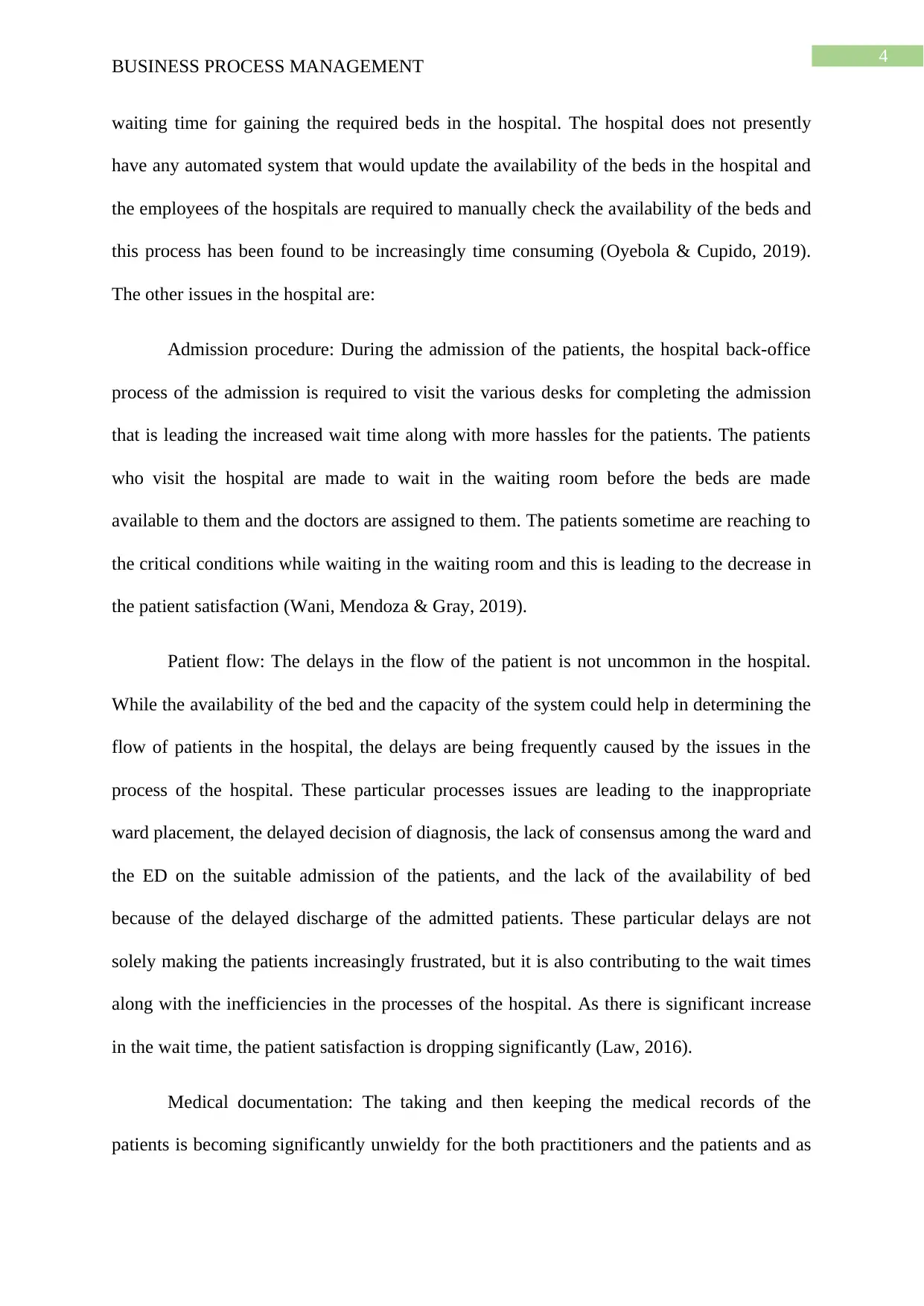
4
BUSINESS PROCESS MANAGEMENT
waiting time for gaining the required beds in the hospital. The hospital does not presently
have any automated system that would update the availability of the beds in the hospital and
the employees of the hospitals are required to manually check the availability of the beds and
this process has been found to be increasingly time consuming (Oyebola & Cupido, 2019).
The other issues in the hospital are:
Admission procedure: During the admission of the patients, the hospital back-office
process of the admission is required to visit the various desks for completing the admission
that is leading the increased wait time along with more hassles for the patients. The patients
who visit the hospital are made to wait in the waiting room before the beds are made
available to them and the doctors are assigned to them. The patients sometime are reaching to
the critical conditions while waiting in the waiting room and this is leading to the decrease in
the patient satisfaction (Wani, Mendoza & Gray, 2019).
Patient flow: The delays in the flow of the patient is not uncommon in the hospital.
While the availability of the bed and the capacity of the system could help in determining the
flow of patients in the hospital, the delays are being frequently caused by the issues in the
process of the hospital. These particular processes issues are leading to the inappropriate
ward placement, the delayed decision of diagnosis, the lack of consensus among the ward and
the ED on the suitable admission of the patients, and the lack of the availability of bed
because of the delayed discharge of the admitted patients. These particular delays are not
solely making the patients increasingly frustrated, but it is also contributing to the wait times
along with the inefficiencies in the processes of the hospital. As there is significant increase
in the wait time, the patient satisfaction is dropping significantly (Law, 2016).
Medical documentation: The taking and then keeping the medical records of the
patients is becoming significantly unwieldy for the both practitioners and the patients and as
BUSINESS PROCESS MANAGEMENT
waiting time for gaining the required beds in the hospital. The hospital does not presently
have any automated system that would update the availability of the beds in the hospital and
the employees of the hospitals are required to manually check the availability of the beds and
this process has been found to be increasingly time consuming (Oyebola & Cupido, 2019).
The other issues in the hospital are:
Admission procedure: During the admission of the patients, the hospital back-office
process of the admission is required to visit the various desks for completing the admission
that is leading the increased wait time along with more hassles for the patients. The patients
who visit the hospital are made to wait in the waiting room before the beds are made
available to them and the doctors are assigned to them. The patients sometime are reaching to
the critical conditions while waiting in the waiting room and this is leading to the decrease in
the patient satisfaction (Wani, Mendoza & Gray, 2019).
Patient flow: The delays in the flow of the patient is not uncommon in the hospital.
While the availability of the bed and the capacity of the system could help in determining the
flow of patients in the hospital, the delays are being frequently caused by the issues in the
process of the hospital. These particular processes issues are leading to the inappropriate
ward placement, the delayed decision of diagnosis, the lack of consensus among the ward and
the ED on the suitable admission of the patients, and the lack of the availability of bed
because of the delayed discharge of the admitted patients. These particular delays are not
solely making the patients increasingly frustrated, but it is also contributing to the wait times
along with the inefficiencies in the processes of the hospital. As there is significant increase
in the wait time, the patient satisfaction is dropping significantly (Law, 2016).
Medical documentation: The taking and then keeping the medical records of the
patients is becoming significantly unwieldy for the both practitioners and the patients and as

5
BUSINESS PROCESS MANAGEMENT
this process is being done manually in the hospital, it is leading to the increased waiting time
for the patients in the hospital. The manual entry of the records in the hospital is causing the
issue of late registration of the patients, and the increase of the patient frustration in the
hospital. This issue is directly affecting the revenue generation in the hospital as the patients
are not choosing this hospital whenever there is any issue.
BUSINESS PROCESS MANAGEMENT
this process is being done manually in the hospital, it is leading to the increased waiting time
for the patients in the hospital. The manual entry of the records in the hospital is causing the
issue of late registration of the patients, and the increase of the patient frustration in the
hospital. This issue is directly affecting the revenue generation in the hospital as the patients
are not choosing this hospital whenever there is any issue.
⊘ This is a preview!⊘
Do you want full access?
Subscribe today to unlock all pages.

Trusted by 1+ million students worldwide
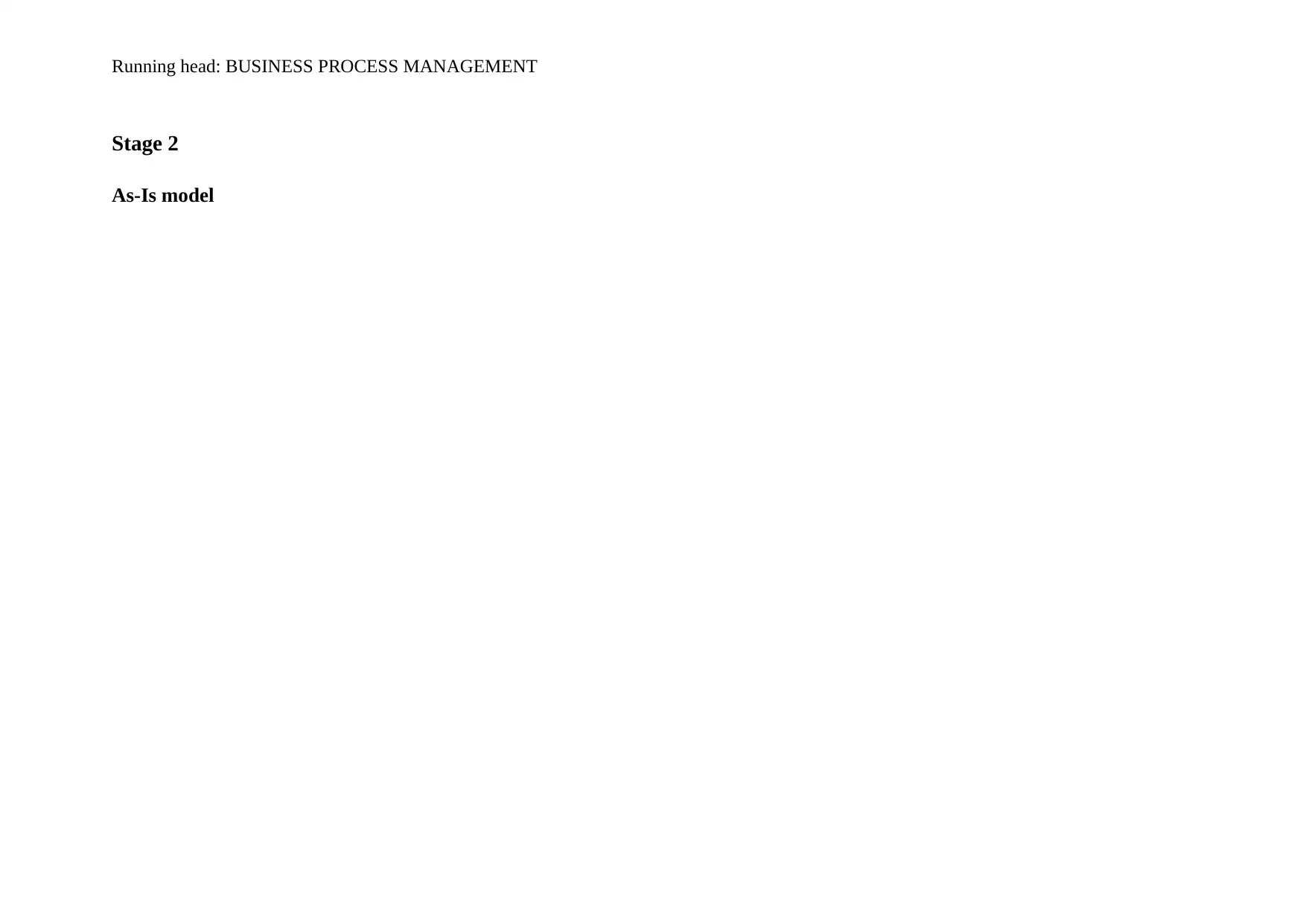
Running head: BUSINESS PROCESS MANAGEMENT
Stage 2
As-Is model
Stage 2
As-Is model
Paraphrase This Document
Need a fresh take? Get an instant paraphrase of this document with our AI Paraphraser
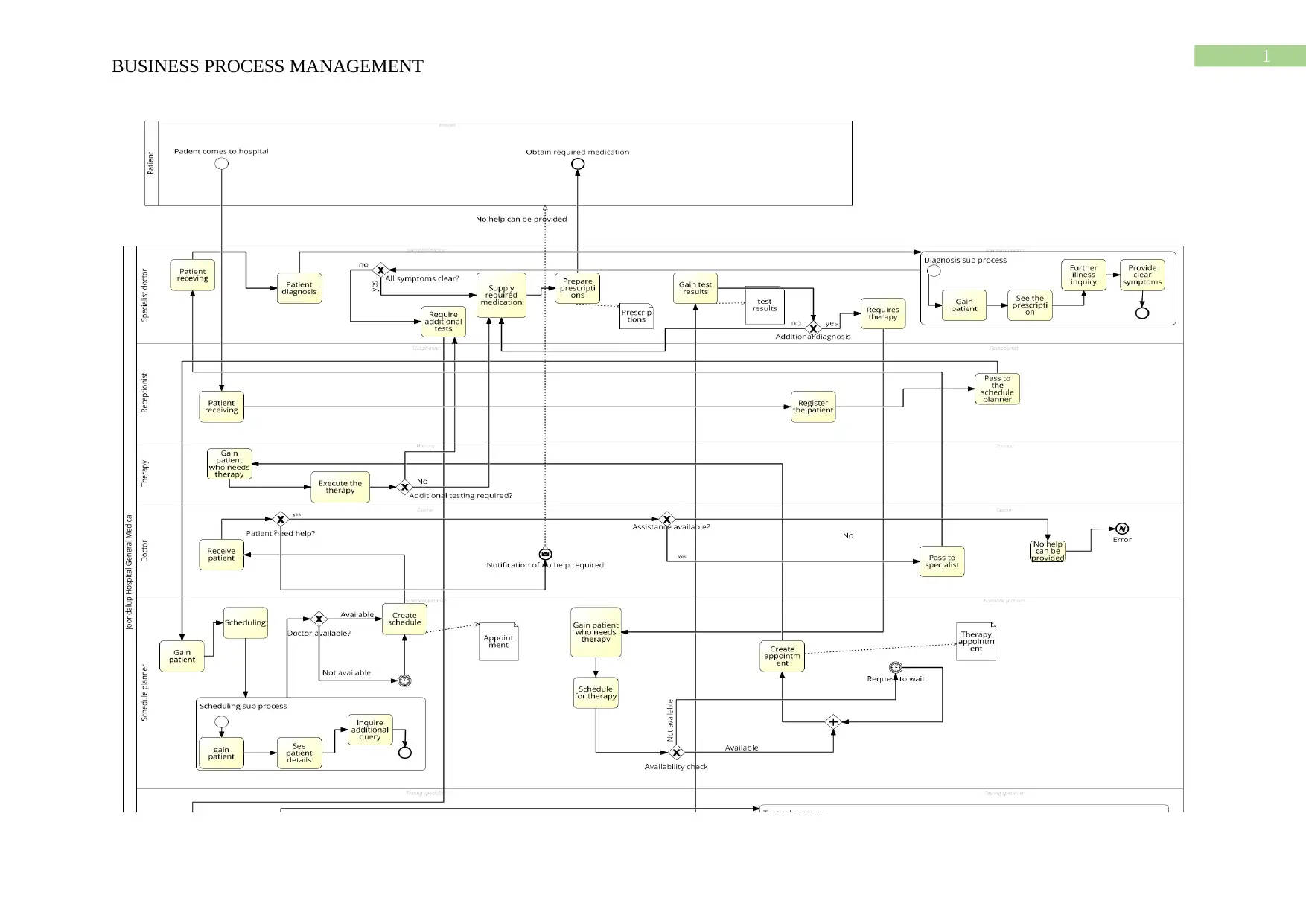
1
BUSINESS PROCESS MANAGEMENT
BUSINESS PROCESS MANAGEMENT
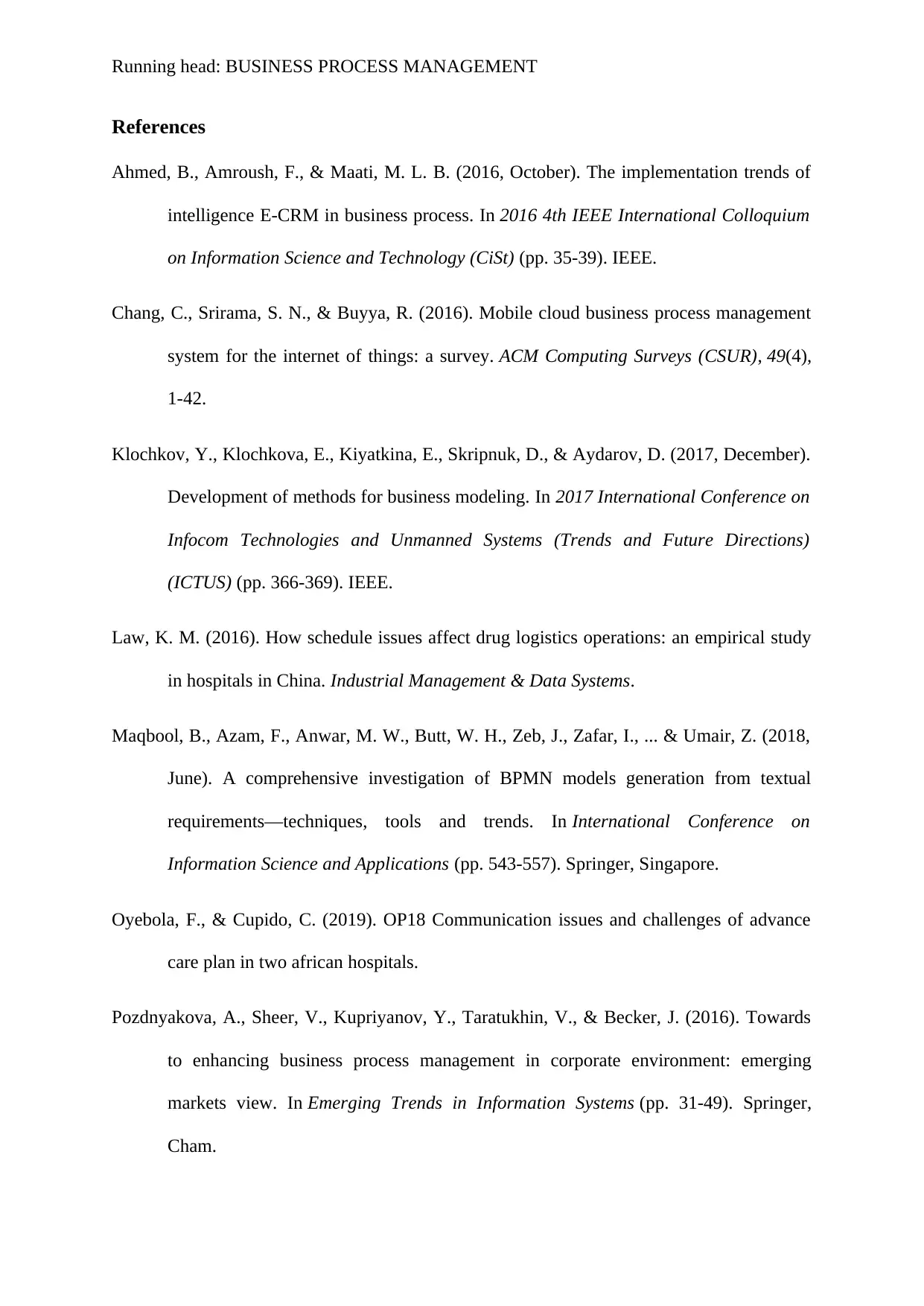
Running head: BUSINESS PROCESS MANAGEMENT
References
Ahmed, B., Amroush, F., & Maati, M. L. B. (2016, October). The implementation trends of
intelligence E-CRM in business process. In 2016 4th IEEE International Colloquium
on Information Science and Technology (CiSt) (pp. 35-39). IEEE.
Chang, C., Srirama, S. N., & Buyya, R. (2016). Mobile cloud business process management
system for the internet of things: a survey. ACM Computing Surveys (CSUR), 49(4),
1-42.
Klochkov, Y., Klochkova, E., Kiyatkina, E., Skripnuk, D., & Aydarov, D. (2017, December).
Development of methods for business modeling. In 2017 International Conference on
Infocom Technologies and Unmanned Systems (Trends and Future Directions)
(ICTUS) (pp. 366-369). IEEE.
Law, K. M. (2016). How schedule issues affect drug logistics operations: an empirical study
in hospitals in China. Industrial Management & Data Systems.
Maqbool, B., Azam, F., Anwar, M. W., Butt, W. H., Zeb, J., Zafar, I., ... & Umair, Z. (2018,
June). A comprehensive investigation of BPMN models generation from textual
requirements—techniques, tools and trends. In International Conference on
Information Science and Applications (pp. 543-557). Springer, Singapore.
Oyebola, F., & Cupido, C. (2019). OP18 Communication issues and challenges of advance
care plan in two african hospitals.
Pozdnyakova, A., Sheer, V., Kupriyanov, Y., Taratukhin, V., & Becker, J. (2016). Towards
to enhancing business process management in corporate environment: emerging
markets view. In Emerging Trends in Information Systems (pp. 31-49). Springer,
Cham.
References
Ahmed, B., Amroush, F., & Maati, M. L. B. (2016, October). The implementation trends of
intelligence E-CRM in business process. In 2016 4th IEEE International Colloquium
on Information Science and Technology (CiSt) (pp. 35-39). IEEE.
Chang, C., Srirama, S. N., & Buyya, R. (2016). Mobile cloud business process management
system for the internet of things: a survey. ACM Computing Surveys (CSUR), 49(4),
1-42.
Klochkov, Y., Klochkova, E., Kiyatkina, E., Skripnuk, D., & Aydarov, D. (2017, December).
Development of methods for business modeling. In 2017 International Conference on
Infocom Technologies and Unmanned Systems (Trends and Future Directions)
(ICTUS) (pp. 366-369). IEEE.
Law, K. M. (2016). How schedule issues affect drug logistics operations: an empirical study
in hospitals in China. Industrial Management & Data Systems.
Maqbool, B., Azam, F., Anwar, M. W., Butt, W. H., Zeb, J., Zafar, I., ... & Umair, Z. (2018,
June). A comprehensive investigation of BPMN models generation from textual
requirements—techniques, tools and trends. In International Conference on
Information Science and Applications (pp. 543-557). Springer, Singapore.
Oyebola, F., & Cupido, C. (2019). OP18 Communication issues and challenges of advance
care plan in two african hospitals.
Pozdnyakova, A., Sheer, V., Kupriyanov, Y., Taratukhin, V., & Becker, J. (2016). Towards
to enhancing business process management in corporate environment: emerging
markets view. In Emerging Trends in Information Systems (pp. 31-49). Springer,
Cham.
⊘ This is a preview!⊘
Do you want full access?
Subscribe today to unlock all pages.

Trusted by 1+ million students worldwide
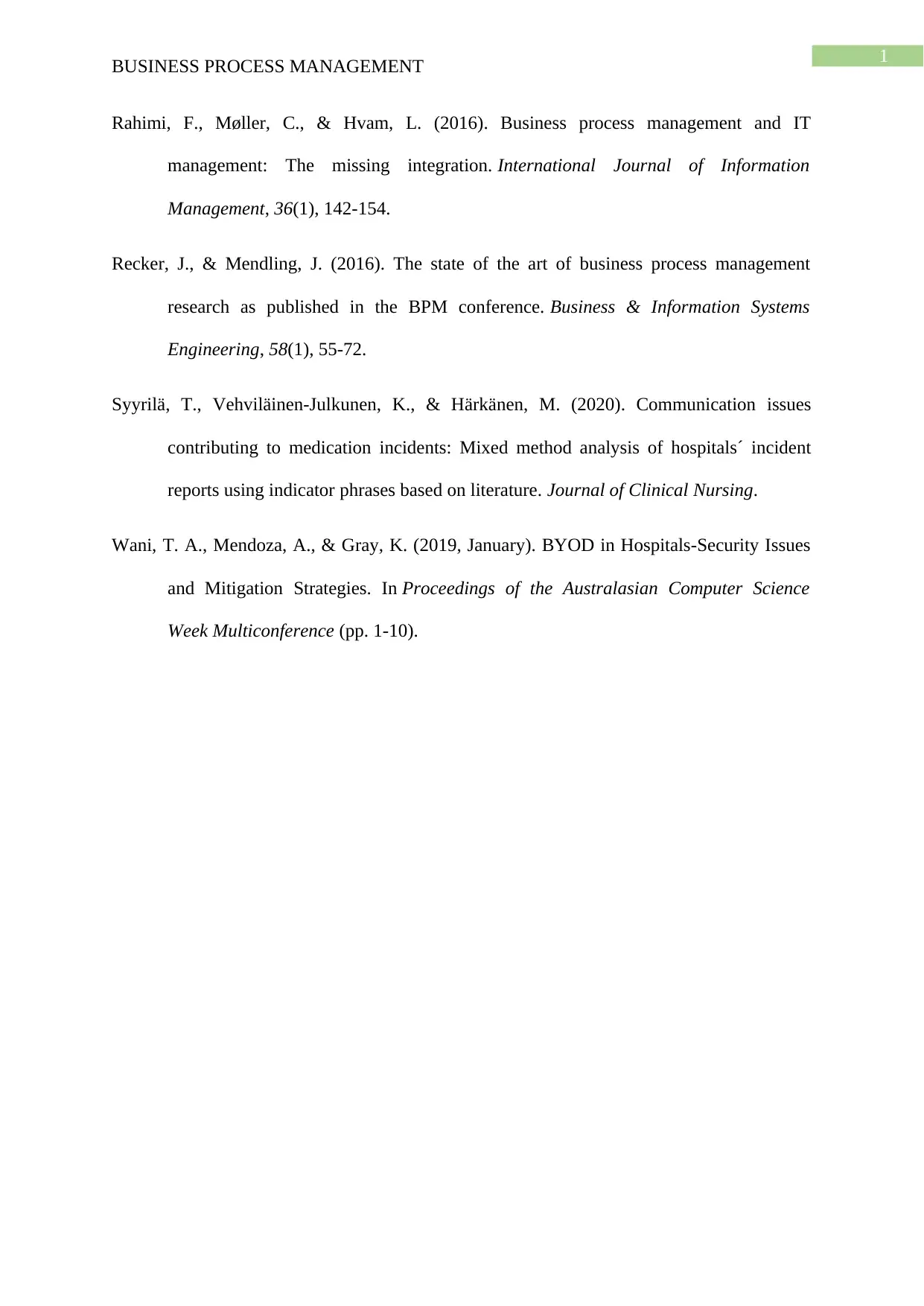
1
BUSINESS PROCESS MANAGEMENT
Rahimi, F., Møller, C., & Hvam, L. (2016). Business process management and IT
management: The missing integration. International Journal of Information
Management, 36(1), 142-154.
Recker, J., & Mendling, J. (2016). The state of the art of business process management
research as published in the BPM conference. Business & Information Systems
Engineering, 58(1), 55-72.
Syyrilä, T., Vehviläinen‐Julkunen, K., & Härkänen, M. (2020). Communication issues
contributing to medication incidents: Mixed method analysis of hospitals´ incident
reports using indicator phrases based on literature. Journal of Clinical Nursing.
Wani, T. A., Mendoza, A., & Gray, K. (2019, January). BYOD in Hospitals-Security Issues
and Mitigation Strategies. In Proceedings of the Australasian Computer Science
Week Multiconference (pp. 1-10).
BUSINESS PROCESS MANAGEMENT
Rahimi, F., Møller, C., & Hvam, L. (2016). Business process management and IT
management: The missing integration. International Journal of Information
Management, 36(1), 142-154.
Recker, J., & Mendling, J. (2016). The state of the art of business process management
research as published in the BPM conference. Business & Information Systems
Engineering, 58(1), 55-72.
Syyrilä, T., Vehviläinen‐Julkunen, K., & Härkänen, M. (2020). Communication issues
contributing to medication incidents: Mixed method analysis of hospitals´ incident
reports using indicator phrases based on literature. Journal of Clinical Nursing.
Wani, T. A., Mendoza, A., & Gray, K. (2019, January). BYOD in Hospitals-Security Issues
and Mitigation Strategies. In Proceedings of the Australasian Computer Science
Week Multiconference (pp. 1-10).
1 out of 10
Related Documents
Your All-in-One AI-Powered Toolkit for Academic Success.
+13062052269
info@desklib.com
Available 24*7 on WhatsApp / Email
![[object Object]](/_next/static/media/star-bottom.7253800d.svg)
Unlock your academic potential
Copyright © 2020–2025 A2Z Services. All Rights Reserved. Developed and managed by ZUCOL.





